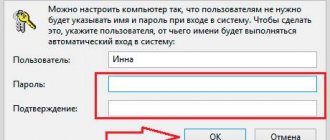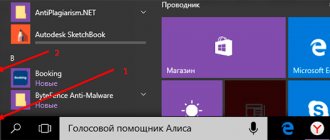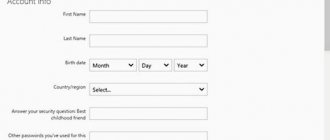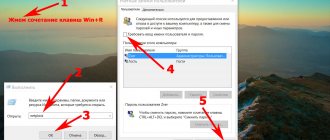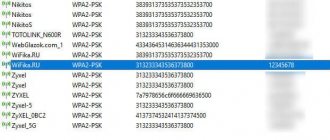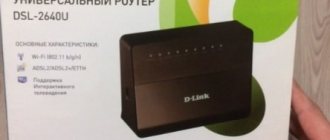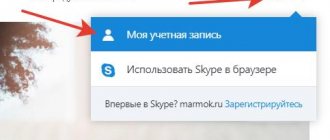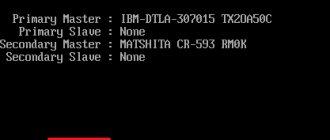What to do if you forgot your computer password? This guide will tell you what to do if you forgot your Windows password and how to solve this problem without reinstalling the operating system. We'll also look at other possible password issues. The Windows 10 and Windows 7 operating systems have improved security capabilities compared to the earlier Windows XP/2000 systems.
By the way, perhaps one of the most commonly used passwords is installed on your PC; see the full list of popular passwords HERE.
The latest versions of Windows use a more effective password system designed for business use to ensure that no one without the necessary permissions can access information on your computer. This is a double-edged sword. Most users forget some important password at least once. And then the user/owner of the information becomes the “enemy without access rights” for his computer.
Naturally, for every security method there is a way to bypass it, especially if you have physical access to the computer.
In this article, we will look at various methods of protecting your computer with a password and how to bypass them. We won't start with user account passwords, but with equally important passwords, such as BIOS passwords.
How to "bypass" the BIOS password?
The BIOS password is one of the oldest ways to protect your computer from unauthorized access and one of the most common. Why? This is one of the most effective means if the user does not have access to the system unit. Otherwise, it is the same as locking your house with many locks and leaving the window open.
The default BIOS settings on all motherboards do not store password information. So all you need to do to remove the BIOS password is simply reset the current settings, restoring the default configuration. But remember that resetting the current BIOS settings will destroy not only the password, but also all the settings that you set yourself.
There are two ways to reset BIOS settings. Most motherboards have a special jumper for clearing CMOS (the memory in which BIOS settings are stored). Usually this jumper is located near the battery on the motherboard, but to be completely sure, it is advisable to refer to the instructions from the motherboard. On some motherboards, instead of a jumper, there are simply two contacts that need to be closed with a metal object, such as a screwdriver, to reset the CMOS.
If your board has a jumper, then to clear CMOS, turn off the computer, install the jumper so that it closes the jumper contacts, and press the computer power button. Your computer will not boot, but your CMOS settings will be reset. Remove the jumper and turn on the computer again. You will most likely see a screen asking you to press F1 to set the BIOS settings. If you are happy with the default settings, press F1 and select 'Save and exit' from the BIOS menu. After this, the computer will boot as usual, except for the BIOS password.
If you don't know where the required jumper is located on your board or if it doesn't exist at all, which is quite possible, you'll have to go a different route. Each motherboard has a battery that powers the CMOS memory, allowing it to store information. As a rule, this is a standard CR2032 battery.
To clear CMOS, turn off the computer and remove the battery (you may need a thin screwdriver). After 5-10 minutes, replace the battery and turn on the computer. The BIOS will be set to default settings and there will be no password. To continue booting, you will need to press the F1 key, and if you are satisfied with the default settings, select 'Save and exit' from the BIOS menu that appears.
As you can see, all this is very simple on a desktop computer, but with a laptop, the BIOS password can become a serious problem. Due to the frequent theft of laptop computers, manufacturers have made it almost impossible to gain access without passing the password. So, if you have forgotten your laptop's BIOS password, most likely you will have to contact the manufacturer's service center.
Recovery stages
So, to recover your Google password, you need to start logging into your account. To do this, go to the website www.google.ru or email and click the “Login” button.
Attention! The mail recovery process will be identical.
A window will then appear asking you to enter your email address. Enter it in the appropriate field and click “Next”.
After this, a field for entering a password will appear, under which there is a “Forgot your password?” button. Let's press it. The system will prompt you to enter the code value that you remember.
If the user does not remember any of the passwords, you need to select another recovery method by clicking the button of the same name. This is confirmation by phone number, which assumes several scenarios. The first is that you logged into Google through a mobile device, but the phone number is not linked to your profile. In this case, you need to do the following:
• If you don't have access to your phone, skip this method or opt in to receive push notifications from Google by clicking Yes.
• Then a notification will appear on your smartphone indicating that they are trying to restore access to your account. And if this is you, you need to click yes.
• Next, you will need to set a new password and use it for further authorizations.
The second scenario is that the phone is already linked to the account. In this case, choose recovery by call or sms.
Important! SMS may be paid, depending on the current tariff of the mobile operator.
After clicking on the “Call” button, a robot call will be received, which will dictate a 6-character code required to be entered on the recovery page. Therefore, you need to be ready to write it down right away. After clicking on the “SMS” button, the code will arrive in the form of a message.
After entering it in the appropriate field, the system will prompt you to set a new password, after which you can use your account again.
Another way to confirm account ownership is the date it was created. Of course, few people remember the exact date, but at least an approximate hit significantly increases the chances of a successful recovery.
If you forgot the month and year, find the date of the first letter sent from friends, ask relatives. In addition, often the creation of an account occurs after the purchase of a phone, and such events, as a rule, are remembered with particular enthusiasm.
When it was not possible to remember the date, enter the approximate value and click the “Another method” button. This is to indicate a backup email address. Having access to it, you can click the “Submit” button and receive a confirmation code.
Go to this email and open the letter from Google. It will contain a six-digit value that you need to enter on the password recovery page and click the “Next” button.
In the case where there was no backup account and you simply entered an additional contact email to receive the code, you can either confirm the status of the owner or receive a refusal, and the system will not offer to create a new password for the account. In this case, you need to choose another recovery method, one of those described above.
After successful login, a form will appear (look at the picture), where by clicking the “Add” button, you can set new confirmation methods.
What to do if you forgot your Windows password?
If circumstances have developed in such a way that you have forgotten your Windows password, then we recommend that you reset it using the built-in account called Administrator. This is done in safe mode, while booting or rebooting your PC.
To restore access to your computer, you will just need to press F8 and in the menu that has already opened, in which you will be presented with some additional options for loading your operating system, you will have to select the aforementioned “Safe Mode”. Next, you will need to select a built-in account, which, by the way, by default, cannot be protected by any password.
If you did everything correctly, since you strictly followed the above sequence of actions, then while still on the Desktop, you should see a window with a message that Windows is running in the “Safe Mode” you need, which is as simplified as possible. You will need to click “Yes” and go to Control Panel - User Accounts, where there is an icon for the account for which you want to reset the password. On the left, you must select “Change Password” and in the appropriate window enter and then confirm a new password. Ultimately, you will need to restart your PC for the above changes to take effect.
How to find out your computer password and where is it saved?
Data is stored in the registry of the Windows operating system. Therefore, every time the system starts, it checks to see if the entered characters match those stored in the registry database. If there is a match, the system begins loading all working modules of the system, and you can continue working with the computer.
If the entered characters do not match, the system asks you to enter the correct key again. If desired, the Administrator can impose a ban on a certain number of input attempts, and then the system will automatically block the user account. Then you can unlock it from the Administrator panel. It will be impossible to hack the system from the launch page, since in this mode the user's attempts are limited. The OS may ask you to enter the correct password on your computer using a hint. But this is only if you took care of it in advance when you created it. In all other cases, you should use other methods to hack the system in order to enter the OS control panel as your user.
How to crack Windows password on a computer or laptop?
In order to do this, you will have to follow the following sequence of actions:
- Prepare a CD or flash drive on which a special set of recovery programs intended to restore Windows should be recorded. You will need to insert it into the drive or into the appropriate port during the subsequent reboot of the computer. You can prepare this package of resuscitation programs yourself by downloading programs intended for separating, saving and restoring data, or you can download some ready-made RBCD 10.0, for example;
- When starting the PC, in order to enter the BIOS, press the “DELETE” button. There we will need to change the installation priority and assign the computer to boot from the CD-ROM. After this we visit our boot disk in the drive and restart the PC;
- Having entered the recovery disk, which should appear after the package of resuscitation programs has been downloaded, we must select the edited copy of Windows and go to the “System Restore” mode - the section that will be located at the very bottom of the page;
- We look for the command line and enter “regedit” there (we look for it in the dialog settings of the same window). We find and then select the HKEY_LOCAL_MACHINE section, in which we need to select File, and then Load hive;
- Open the “SAM” file and select the section - HKEY_LOCAL_MACHINE\hive_name\SAM\Domains\Account\Users\000001F4. Double-click on the F key located there and go to the very first value located in the line, which we will need to replace with the number 10;
- In the same section, select “File”, and then “Load Hive”. Click “Yes” to confirm unloading the bush. We close the registry editor, thus completing the installation process, take out the flash drive or disk and reboot the computer.
Hacking the admin password
This is a more complex, but possible procedure for hacking an administrative account. It occurs using a resuscitation disk with a specific set of software. In the disk menu, you need to select a copy of the OS to edit and go to the “System Restore” section. Here in the dialog settings you need to select “Command Line”, enter regedit and confirm the launch of the program to edit the contents of the registry. Then you need to find the section called HKEY_LOCAL_MACHINE and select the “Load hive” command in it. Next, open the subsection with 888 Setup and edit the value after the CmdLine key by double-clicking it. In the open command line, enter the cmd.exe configuration and save by clicking “OK”. In the next step, you need to set the value “2”, focusing on the SetupType key. Save all configurations for changes to the subkey for 888, specify the hive dump file, and reboot the computer. Then enter the net user login in the username field and create a new password when you turn on the computer. And this issue with hacking the admin panel will be resolved.
How to find out the administrator password in Windows 7?
Again, it’s much easier to just reset the password and come up with a new one afterwards. However, if you specifically need to find out the password, we recommend that you use a program for this purpose called Elcomsoft System Recovery Professional, from the image of which you will need to make a bootable disk. Having correctly configured the BIOS boot from the drive and installed this program, immediately upon entering the Desktop, a window will open in which you can see user names, including the Administrator, as well as passwords for their accounts.
Saved passwords in Yandex browser: view, delete, save
Users who spend a lot of time on the Internet often register on various sites, but after some time they forget the entered logins and passwords. For such cases, browsers have added the ability to save entered passwords, and if you suddenly forgot, there is an opportunity to view the saved passwords.
Yandex browser is perhaps the most popular browser in Russia. It is constantly updated, and the user does not understand where the settings he was used to went to, and many were not familiar with them at all. In this article I will tell you how to view, delete and save passwords in the Yandex browser.
How to view passwords in Yandex browser
Many users are interested in where the passwords are in the Yandex browser. With the latest changes, access to them has become easier. In the upper right corner, click Menu and select Password Manager.
Here are all saved passwords in the Yandex browser. For ease of searching, the list of sites is in alphabetical order, first domains starting with numbers, then Latin, and lastly Russian-language ones. Find the required site with your login. Click on it once.
To view the password, you need to click on the peephole, as indicated in the screenshot below. If a window appears asking you to enter the Windows account password, you will have to confirm the user rights, the same ones that you enter when starting Windows.
How to remove passwords in Yandex browser
Sometimes, for certain reasons, it is necessary to delete the saved password in the Yandex browser. To do this, point to the favicon (icon) and check the box that appears. You can mark the required number of saved accounts and click Delete. If you want to delete everything, you can check the empty box at the very top next to the Website inscription.
How to save a password in the Yandex browser
In order for entered logins and passwords to be saved automatically, the following lines must be checked in the Password Manager settings:
- Allow sites to save passwords in the browser for automatic login.
- Save passwords by default
To autofill forms so as not to enter them manually, the following must be checked:
- Automatically fill in authorization forms
For security, I recommend creating a master password. It will encrypt all other passwords so only you can use and manage them. If you do not need the password saving feature, you can disable it by clicking Turn off password manager.
How to reset password on Windows 7?
When wondering: what to do if you forgot the password from your own PC, it is not at all necessary to use the above methods for restoring it. You can also reset your password in the Windows 7 operating system using the Net User command. To do this, while rebooting the PC you will need to press F8. Thus, you can open a Menu that allows you to make additional options for loading this operating system, in which you will need to select not just “Safe Mode,” but one that also supports the command line. While in it, you will need to select the built-in Administrator account and in the Command Interpreter window, immediately after this, system prompts will appear where you will need to enter net user “username” “password”.
We assume that you yourself understand that instead of “username” you will need to enter the name of your local user account, and instead of “password” you will need to enter a new password. If you did everything correctly, then in order to close the window, you will need to enter exit on the command line and restart the PC.
Password program on your computer
How to find out the user's password? Today it is not surprising that there is a lot of exclusive software, including for hacking systems. There are a lot of such utilities, and they are all available on the Internet. The features of hacking a computer system are the same as by resetting it via a Microsoft miniPE disk. In fact, the same procedure for logging in through “BIOS” with changing the system boot via an external drive (flash drive, CD-ROM). The password program on the computer is used for cracking and runs when it is rebooted. The only caveat: such programs are not always reliable and can damage the operating system as a whole. They can take advantage of OS vulnerabilities and inject spyware, erase registry files, or uninstall the OS.
How to reset your password on Windows 8?
In the case of this operating system, things are much simpler! You can reset your password on Windows 8 as follows:
- On the login screen, you will need to click on the special power icon, which is located in the lower right corner of your screen;
- Next, you will need to press the Shift key and click “Restart”;
- Click "Troubleshoot";
- Click Reset PC;
- Click “Next” and the system will automatically reboot in order to begin preparations for resetting the password.
Where can you store passwords on Android?
You can write down passwords in notes or a text pad, then save this file with a .txt and “hide” it. To do this, you need to create a folder with the security code in the root directory and transfer the finished file to it. You will only need to remember one code - from the folder itself.
There are several applications for storing ciphers in the Play Market, among them the following are popular:
- mSecure Password Manager;
- RoboForm;
- KeepPassDroid;
- Last Pass.
We recommend: Problems with launching the YouTube application on Android
The principle of their operation is identical: the application window is a file where passwords are entered in a list. Login to the utility is protected by your own PIN code - you must remember it.
Important! Among the keys, the fingerprint is considered the most secure; today it is present even on budget smartphones and some tablets.
How to reset Windows 7 administrator password?
The best way to reset the Windows 7 administrator password is through the Windows Command Interpreter. Follow the following sequence of actions:
- First, launch it. You can do this by following the following path: Start - Run - Run the program - cmd. In the Command Interpreter menu that opens, you will need to enter: control userpasswords, after which a window called “User Accounts” will open;
- Select the account for which you want to reset the password and do not forget to uncheck the box next to “Require username and password”;
- In the window that opens, you will be required to enter and then confirm a new password. Next, in the command boot window you will need to enter Exit and restart the PC as usual.
How to change a user's password?
If you have not yet logged out of the system and are in the Administrator panel, then you can easily reset the key without performing any special actions. You just need to go through “Start” to “Settings”, select the “User Accounts” menu and in the tab of the user you are interested in, select the “Reset Password” menu. The system will prompt you to enter a new one, you can do this procedure or leave the fields blank. Next, save the settings by clicking “OK”. This will complete the work of changing the key.
View the passwords that Windows stores
In addition to the access passwords of various users, Windows also stores a number of others, no less important: the password for connecting to the Internet, passwords for mailboxes or access to websites. As a rule, there are quite a lot of them, so it is quite natural that they are forgotten over time.
The operating system offers an “autofill” function for passwords and other frequently entered information in browsers (Google Chrome, Yandex Browser, Opera (Blink), Firefox, Explorer 11, etc.). So it is not uncommon for a user to enter a password once, and after a few months, naturally, cannot remember it. Everyone understands that important passwords need to be written down, but not everyone does this. And if you no longer remember the password, how can you find it out, since it is displayed as a series of asterisks: ******?
The solution is offered by programs from different manufacturers that can obtain the password from this string of asterisks. There are quite a lot of freely available programs for decrypting Windows passwords or hidden passwords from input lines in various browsers.
We will use the Asterisk Key program from Passware. This is an easy-to-use, freely distributed program that analyzes passwords hidden by asterisks and reports them to you. She is very easy to work with. Just select the password line and click the 'recover' button.
Of course, there are also commercial versions of programs, which, as a rule, have a greater range of functions. For example, Password Recovery Toolbox scans the system and identifies saved passwords, data saved for automatic filling, Outlook Express passwords, Internet connection passwords, etc. This information is then presented in a convenient form. A few more alternatives to the programs described above: Pwdcrack, Peeper Password or Password Viewer.
Windows XP user passwords
Windows XP stores user passwords in a modified form. For example, the password "password" would be stored as a string like this: 'HT5E-23AE-8F98-NAQ9-83D4-9R89-MU4K'. This information is stored in a file called SAM in the C:\windows\system32\config folder.
This portion of the SAM file is encrypted by the syskey system utility to improve password security. The data necessary to decrypt the information after syskey is stored in the system file in the same folder. But this folder is not available to any user. Only the operating system itself has access to it during its operation. You can access the SAM and system files only when running a different operating system or by connecting the drive to another Windows computer.
Resetting user passwords in administrator mode in Windows XP
All versions of Windows XP have an "administrator" account. This name gives the user full access to the system and the ability to reset the passwords of all other users. This can save you if for some reason you cannot log in with your regular user password. The specifics of using the administrator password depend on the version of Windows XP: XP Professional.
The administrator password is set during installation of the operating system. If you wrote it down or just pressed enter and left it blank, you can easily log in as an administrator and reset user passwords. To log in to the system in administrator mode, on the system welcome screen, press CTRL+ALT+DEL twice, a window for entering the administrator password will appear.
When the computer boots, go to 'start\control panel\user accounts' (start\control panel\user accounts) and change the required password. Since you are already here, this is a good opportunity to correct your mistake if you left the administrator password blank. In addition, it is advisable to change the name of the 'adminisrator' account. This name is known to everyone and is the first name used to gain access to your computer. To change the account name, right-click on 'my computer' and select 'manage'. Expand 'local users and groups' and open the 'users' folder. Right-click on the 'administrator' entry and edit it. XP Home.
This system will not allow you to simply access your computer in administrator mode. First, you will need to boot your computer into crash protection mode. To do this: restart your computer; immediately after testing the BIOS, press F8 several times; In the menu that appears, select 'start Windows XP in safe mode'. When the computer boots, log in with the username 'administrator'. There is no default password. You can now change user passwords by going to 'start\control panel\user accounts'. When you're done, restart your computer as usual. Creating a password reset disk
Windows XP allows you to write information to a regular floppy disk, which provides the ability to reset your password. Naturally, if you have already forgotten the password and cannot access the system, then you will not be able to create any disk, but it is worth creating such a floppy disk in advance to protect yourself from such accidents.
To create a floppy disk: go to 'start\control panel\user accounts' (start\control panel\user accounts); select the name under which you are logged in; In the related tasks menu, select 'prevent a forgotten password'; follow the instructions of the wizard that starts.
To reset passwords using a floppy disk: if you enter the login password incorrectly, the system will ask whether you have forgotten it; At this point, you will be able to use your floppy disk by following the operating system's step-by-step instructions.
Be careful: if you used Windows' built-in file and folder encryption capabilities but did not install the operating system update (service pack 1), removing the password will result in the loss of encrypted information.
Utilities for changing passwords Windows XP/7/8/10
There are special utilities that allow you to edit or reset Windows XP/7/8/10 user passwords. The principle of most of them is to load a minimal version of an alternative operating system, such as DOS or Linux, under which you can access files with passwords.
An example of such a utility can be found at this address: https://home.eunet.no/~pnordahl/ntpasswd/ Instructions for operation, as well as files for creating a bootable Linux disk, are available on the same site.
Please note that if you have used the operating system's functions to encrypt files and folders, changing the password using any program will cause you to lose access to the encrypted data. In this case, the following method can help, allowing you not to replace the forgotten password with a new one, but to find out the old one.
Selection and decryption of passwords
If nothing else helps, but you have physical access to the computer, then all is not lost. You can rewrite the config and SAM files and try to decrypt the passwords stored in them using special third-party utilities. As we already said, for this you will have to use an alternative operating system, such as DOS or Linux. And once you have the files, you can use one of the password decryption programs, such as LC4 or Proactive Windows Security Explorer.
You will need:
- Access to another computer.
- At least two empty floppy disks.
- An archiver designed to work with the command line, for example, RAR.
- A DOS or Windows 98 boot disk (an image of the required disk can be obtained at https://www.bootdisk.com/) or a minimal version of Linux (for example, Knoppix). There is no need for boot disks if you can simply connect your hard drive to another computer. If you are using a DOS boot disk and the partitions on your hard drive use the NTFS file system, then to access them you will need a program that allows you to view NTFS partitions under DOS, such as NTFSDOS.
- Program for obtaining passwords. We recommend using Proactive Windows Security Explorer as the beta version of this program is free and the free version of LC4 is very limited.
Using a bootable USB flash drive:
- If your hard drive has NTFS partitions, copy the NTFSDOS file to your bootable USB flash drive.
- Copy the archiver (RAR) to the bootable USB flash drive.
- Boot your computer from this flash drive. If there are partitions with NTFS, type the NTFSDOS command, this program will show which letter is assigned to your system drive, and you will need to use it instead of the letter C in the next step.
- Place system files with passwords in the archive. For example, if you are using the rar32 archiver, the corresponding command will look like this: Rar32 a -va:\systemandsam c:\windows\system32\config\system c:\windows\system32\config\sam If the files do not fit on one flash drive, the archiver will ask you to insert a second one.
Hacking passwords
Each program you select will display a list of accounts detected in the SAM file. Select those for which you need to define passwords. If you are using Proactive Windows Security Explorer, select Attack type: Brute-force. If you used only numbers in your password, check the 'all digits (0-9)' checkbox. Start the password recovery process using the command from the Recovery menu.
Password guessing can last from 10 minutes to several hours, or even several days, and may fail. Especially if the password uses letters in different cases, numbers and special characters.
This is a good way to check the strength of your passwords. If you just want to check your password, follow the steps above and see how long it takes to guess it.
Windows password cracking programs
There are a huge number of software tools that can help you crack your Windows password. Apart from the above-mentioned program, there is also Windows Admin Password Hack. But, unfortunately, it can no longer be called current, since it only works in Windows 2000/XP. Its closest replacement is MultiBoot 2k10, which is essentially a feature-rich boot disk.
conclusions
In any case, if one of your loved ones forgot the password for Windows 7, or you yourself were forced to face this, do not despair, there are plenty of solutions to this problem. Well, so that you no longer have questions about how to crack a password on a laptop, we strongly recommend that you save them somewhere, in notes inside your own smartphone, for example.
We hope you don't have to resort to the methods we've described. To avoid this need, remember to write down all important passwords. And if there is a real need to protect information on your computer, then use passwords made of characters in both registers and numbers and do not use ordinary words. In this case, your passwords will be very difficult to crack.
Ways to delete saved passwords in Yandex browser
It's easy to share with friends - just click a button.
Instructions on how to delete a saved password in the Yandex browser on a computer and on a smartphone differ. Also, the sequence of actions required for this varies depending on whether you need to erase access data for one resource or for all.
Once you are in the list of saved passwords, you can begin deleting them.
Saving passwords in the Yandex browser
The Yandex browser has a mechanism for reading data entered in the “Login” and “Password” fields. They are saved in an encrypted file placed in the same directory where the program itself is stored. This feature is intended for those who are afraid of forgetting account access codes. It can be disabled by the user.
Before taking any action, we recommend downloading the latest version of Yandex Browser. New versions of the program improve the speed and stability of work.
Why you need to remove passwords
You need to remove the code that gives access to your account in the following cases:
- more than one person works on the computer;
- it is planned to return the gadget to a service center;
- there is a risk that the device will be stolen or infected with a virus.
After the user erases the account access code from the browser, he will not be able to cancel this action and use auto-fill in the login and password fields for authorization.
How to remove passwords selectively
It is possible to delete data necessary to access one or more sites. This will allow you to protect your most valuable accounts without depriving yourself of the convenience of quick authorization on less important portals.
Quite often you need to selectively remove passwords.
On PC
On a personal computer or laptop running the Windows 7 operating system, you can delete data for accessing the selected account using the following scheme:
- Left-click on the icon depicting 3 parallel lines. It is located next to the line containing the address of the site you are viewing.
- In the drop-down menu, select “Passwords and cards”.
- In the list of Internet resources that appear for which access data has been saved, find the one you need and right-click on it.
- Select “Delete” from the drop-down menu.
The password manager also allows you to change previously stored information.
On a smartphone
On a smartphone, deleting a separate access code is carried out according to the following instructions:
- Launch the browser.
- While on the main page, click on the icon with the “ellipsis” symbol located at the top of the gadget screen.
- In the menu that appears, select “Settings”.
- Scrolling through the menu that appears, find the “List of Passwords” section.
- In the proposed list of portals for which the information required for authorization is stored, click on the one you need and select “Delete”.
Where are passwords stored?
Just 5-7 years ago, passphrases in popular applications were stored in a file in the form of unencrypted text. Since then, technologies for protecting personal data have increased exponentially. The file where passwords are stored in Yandex Browser on a computer is encrypted. Data is written as hashes rather than text characters. If you try to decrypt such a file, then even a powerful PC will not cope with this task during continuous operation for the next hundred years: the algorithms are extremely resistant to hacking.
Contents of the file with personal data. What you are looking for is in the fourth line, but is encrypted as a hash. There's no chance of decoding it.
Knowing where saved passwords are stored in Yandex Browser is only useful for backup purposes. It is convenient to keep such important data at hand in case of problems with the OS or hard drive. The Ya Login Data file is located deep in the depths of the user profile: C:\Users\user_name should be here\AppData\Local\Yandex\YandexBrowser\User Data\Default

